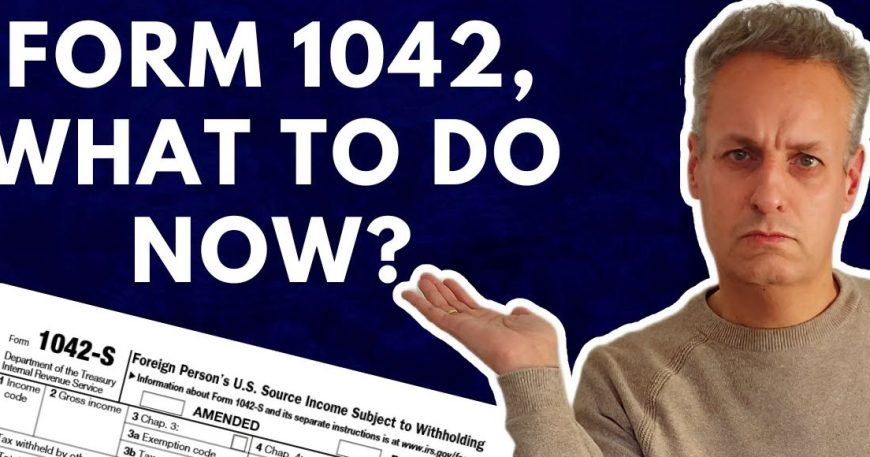Navigating with Syed Professional Services
The world of international finance can be complex, especially when navigating tax regulations. Understanding Forms 1042 and 1042-s form is crucial for ensuring proper withholding and reporting for businesses and individuals in the U.S. making payments to foreign persons. This informative guide by Syed Professional Services sheds light on these forms, their filing requirements, and how our team can assist you in complying with U.S. tax regulations for foreign payees.
Understanding Form 1042: Withholding Tax on Foreign Income
Form 1042, officially titled “Annual Withholding Tax Return for U.S. Source Income of Foreign Persons,” is an IRS form used by withholding agents to report income tax withheld on certain payments made to foreign persons. A withholding agent is any U.S. person (individual, corporation, partnership, etc.) responsible for withholding income tax from payments made to foreign persons.
Who Must File Form 1042? Understanding the Filing Requirements
Only some people who pay foreign persons need to file Form 1042. Here’s a breakdown of the filing requirements:
- Withholding Requirement: Generally, you only need to file Form 1042 if you must withhold income tax from payments made to foreign persons. The types of income subject to withholding can include:
- Interest
- Dividends
- Rents
- Royalties
- Certain gains from the sale of U.S. property
- Tax Treaty Benefits: If the foreign person is a resident of a country with a tax treaty with the U.S., the treaty might reduce or eliminate the withholding requirement. You must consult the specific treaty provisions to determine if withholding applies.
- Minimum Payment Thresholds: In some cases, there might be minimum payment thresholds below which withholding isn’t required. These thresholds can change, so staying updated on IRS guidance is essential.
Understanding Form 1042: Key Information Required
While Form 1042 might appear complex, it’s a relatively straightforward form once you know the information needed:
- Withholding Agent Information: Fill in your contact details and tax identification number as the withholding agent.
- Foreign Payee Information: Provide details about the foreign person receiving the income, including name, address, foreign tax identification number (if applicable), and treaty benefits claimed (if any).
- Income Paid and Withholding Amount: Report the total revenue paid to the foreign person and the income tax withheld.
- Tax Treaty Information: If a tax treaty applies, indicate the relevant treaty provisions and any reduced withholding rates.
1042-s Form: Reporting Payments to Foreign Persons
Form 1042-S, titled “Foreign Person’s U.S. Source Income Subject to Withholding,” is an information return that complements Form 1042. While Form 1042 reports the tax withheld, 1042-s form reports the total income paid to the foreign person.
Who Needs to File Form 1042-S? Understanding the Filing Requirements
The same withholding agent who files Form 1042 must also file Form 1042-S for each foreign person to whom they made a payment subject to withholding (even if no tax was ultimately withheld due to a tax treaty or other reasons). There is no minimum payment threshold for filing Form 1042-S.
Understanding Form 1042-S: Key Information Required
Form 1042-S requires similar information to Form 1042, focusing on the foreign payee and the income details:
- Foreign Payee Information: Fill in the foreign person’s name, address, and foreign tax identification number (if applicable).
- Income Paid and Withholding Amount: Report the total revenue paid to the foreign person during the tax year and the amount of income tax withheld (if any).
Recent Changes to Form 1042 Filing Requirements (as of October 26, 2023):
The IRS periodically updates withholding tax regulations and filing requirements. As we approach October 26, 2023, it seems there are no significant alterations disclosed for Forms 1042 and 1042-S. Nonetheless, I suggest giving the IRS website a look-see to catch any updates that might have surface prior to filing.
When are Forms 1042 and 1042-S Due?
The due date for Forms 1042 and 1042-S is March 15, the following calendar year in which the income subject to reporting was paid. If March 15 falls on a Saturday, Sunday, or legal holiday, the due date is the next business day.
Here’s an additional point you can add to your blog post:
It’s important to remember that a six-month automatic extension of time to file Form 1042 is available by filing Form 7004, Application for Extension of Time to File Certain Excise, Income, Information, and Other Returns. However, this extension applies only to filing the form, not to paying any tax that may be due.




